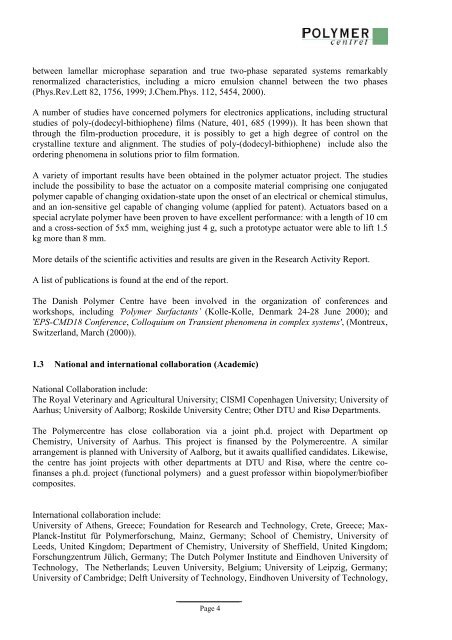The Danish Polymer Centre 1999/2000 - DPC
The Danish Polymer Centre 1999/2000 - DPC
The Danish Polymer Centre 1999/2000 - DPC
Create successful ePaper yourself
Turn your PDF publications into a flip-book with our unique Google optimized e-Paper software.
etween lamellar microphase separation and true two-phase separated systems remarkably<br />
renormalized characteristics, including a micro emulsion channel between the two phases<br />
(Phys.Rev.Lett 82, 1756, <strong>1999</strong>; J.Chem.Phys. 112, 5454, <strong>2000</strong>).<br />
A number of studies have concerned polymers for electronics applications, including structural<br />
studies of poly-(dodecyl-bithiophene) films (Nature, 401, 685 (<strong>1999</strong>)). It has been shown that<br />
through the film-production procedure, it is possibly to get a high degree of control on the<br />
crystalline texture and alignment. <strong>The</strong> studies of poly-(dodecyl-bithiophene) include also the<br />
ordering phenomena in solutions prior to film formation.<br />
A variety of important results have been obtained in the polymer actuator project. <strong>The</strong> studies<br />
include the possibility to base the actuator on a composite material comprising one conjugated<br />
polymer capable of changing oxidation-state upon the onset of an electrical or chemical stimulus,<br />
and an ion-sensitive gel capable of changing volume (applied for patent). Actuators based on a<br />
special acrylate polymer have been proven to have excellent performance: with a length of 10 cm<br />
and a cross-section of 5x5 mm, weighing just 4 g, such a prototype actuator were able to lift 1.5<br />
kg more than 8 mm.<br />
More details of the scientific activities and results are given in the Research Activity Report.<br />
A list of publications is found at the end of the report.<br />
<strong>The</strong> <strong>Danish</strong> <strong>Polymer</strong> <strong>Centre</strong> have been involved in the organization of conferences and<br />
workshops, including ’<strong>Polymer</strong> Surfactants’ (Kolle-Kolle, Denmark 24-28 June <strong>2000</strong>); and<br />
’EPS-CMD18 Conference, Colloquium on Transient phenomena in complex systems', (Montreux,<br />
Switzerland, March (<strong>2000</strong>)).<br />
1.3 National and international collaboration (Academic)<br />
National Collaboration include:<br />
<strong>The</strong> Royal Veterinary and Agricultural University; CISMI Copenhagen University; University of<br />
Aarhus; University of Aalborg; Roskilde University <strong>Centre</strong>; Other DTU and Risø Departments.<br />
<strong>The</strong> <strong>Polymer</strong>centre has close collaboration via a joint ph.d. project with Department op<br />
Chemistry, University of Aarhus. This project is finansed by the <strong>Polymer</strong>centre. A similar<br />
arrangement is planned with University of Aalborg, but it awaits quallified candidates. Likewise,<br />
the centre has joint projects with other departments at DTU and Risø, where the centre cofinanses<br />
a ph.d. project (functional polymers) and a guest professor within biopolymer/biofiber<br />
composites.<br />
International collaboration include:<br />
University of Athens, Greece; Foundation for Research and Technology, Crete, Greece; Max-<br />
Planck-Institut für <strong>Polymer</strong>forschung, Mainz, Germany; School of Chemistry, University of<br />
Leeds, United Kingdom; Department of Chemistry, University of Sheffield, United Kingdom;<br />
Forschungzentrum Jülich, Germany; <strong>The</strong> Dutch <strong>Polymer</strong> Institute and Eindhoven University of<br />
Technology, <strong>The</strong> Netherlands; Leuven University, Belgium; University of Leipzig, Germany;<br />
University of Cambridge; Delft University of Technology, Eindhoven University of Technology,<br />
Page 4


